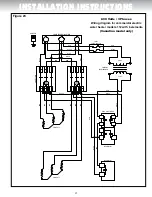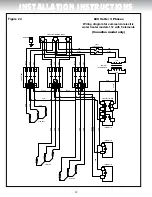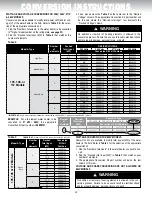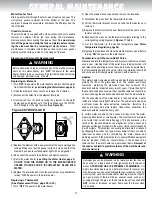
35
condition
cause
ReMedy
no hot water.
Dry-fired element.
Replace with new element.
Main power supply is “OFF”.
Turn “ON” main power supply.
Burnt fuse.
Replace with new fuse.
Circuit breaker has tripped.
Reset circuit breaker.
High limit reset control has tripped.
Reset high limit control by pushing
the reset button.
Circuit breaker is defective.
Replace with new circuit breaker.
Defective thermostat.
Replace with new thermostat.
Defective element.
Replace with new element.
not enough hot water.
Water heater is undersized.
Install size of water heater that meets demand.
High hot water demand.
Increase the temperature of the thermostat.
Very cold water supply.
Increase the temperature of the thermostat.
Wrong piping connections.
Correct piping.
Sediment or lime accumulation at bottom
of water heater.
Drain water heater. Check to see if water treatment
is necessary.
Hot water plumbing system leaks.
Check hot water plumbing system for leaks and repair.
Thermostat adjusted too low.
Increase the temperature of the thermostat.
Defective thermostat.
Replace with new thermostat.
Defective element.
Replace with new element.
Long runs or exposed piping.
Insulate piping.
Hot water piping on outside wall.
Insulate piping.
boiling hot water.
Thermostat temperature set too high.
Lower the temperature on the thermostat.
Thermostat not in contact with water heater. Position properly. Be sure insulation is not
interfering with thermostat.
Element attacked by CO
2
.
Replace with new element.
Defective thermostat.
Replace with new thermostat.
continuous operation.
Water heater is undersized.
Install size of water heater that meets demand.
Element wattage too small.
See
Conversion Guide.
Thermostat not in contact with water heater. Position properly. Be sure insulation is not
interfering with thermostat.
Thermostat temperature set too low.
Increase the temperature of the thermostat.
Defective thermostat.
Replace with new thermostat.
Defective high limit reset control.
Replace with new high limit reset control.
element failure.
Wiring connections are wrong.
see figures 11 to 24 for correct wiring.
Wiring connections are loose.
Locate, clean carefully, reconnect properly.
Lightning/Power surge.
Inspect/replace fuse, element, and thermostat.
High voltage.
Check with electrical utility and correct.
Short circuit.
Locate short circuit and repair.
thermostat failure.
No power.
Inspect fuse/circuit breaker, replace/reset.
Loose wiring connection.
Locate, clean carefully, reconnect properly.
Lightning/Power surge.
Inspect/replace fuse, element, and thermostat.
Low/High voltage.
Check with electrical utility and correct.
Short circuit.
Locate short circuit and repair.
blown fuse/circuit breaker.
Wiring connections are wrong.
see figures 11 to 24 for correct wiring.
Wiring connections are loose.
Locate, clean carefully, reconnect properly.
Lightning/Power surge.
Inspect/replace fuse, element, and thermostat.
High voltage.
Check with electrical utility and correct.
Short circuit.
Locate short circuit and repair.
Power supply wiring undersized.
see table 1 and consult electrical code for correct wire size.
fuse burns instantly.
Short-circuit.
Locate short circuit and repair.
fuse burns often.
Fuse contacts oxidized or fuse not screwed
in tight enough.
Clean contacts and tighten fuse.
Power supply wiring is undersized.
see table 1 and consult electrical code for correct wire size.
TROUBLESHOOTING GUIDE
condition
cause
ReMedy
smoking wiring.
Lightning/Power surge.
Inspect/replace fuse, element, and thermostat.
Low/High voltage.
Check with electrical utility and correct.
Power supply wiring undersized.
see table 1 and consult electrical code for correct wire size.
service wires charred or hot.
Wiring connections are wrong.
see figures 11 to 24 for correct wiring.
Water heater not properly grounded.
Properly ground the water heater.
Lightning/Power surge.
Inspect/replace fuse, element, and thermostat.
High voltage.
Check with electrical utility and correct.
Short circuit.
Locate short circuit and repair.
Power supply wiring undersized.
see table 1 and consult electrical code for correct wire size.
drain valve leaks.
Drain valve is open.
Close the drain valve.
Defective drain valve.
Replace with new drain valve.
water drips from the
relief valve.
Excessive water pressure.
Install a pressure-reducing valve.
Thermal expansion in a closed water
system.
Install a suitable expansion tank on the cold water
supply line.
Improperly seated relief valve.
Check relief valve works properly and replace, if neces-
sary.
Defective thermostat.
Replace with new thermostat.
Defective relief valve.
Replace with new relief valve.
water on the floor/drain pan.
Water discharge from the relief valve.
see
Pressure build-up in a water system.
Element leaks.
Replace with new element and gasket.
Water heater leaks.
Replace with new water heater.
wet insulation.
Leaking plumbing connections.
Locate leak and repair.
Leaking around heating element.
Tighten, clean, and smooth face of tank flange and replace
element gasket.
Water discharge from the relief valve.
see
Pressure build-up in a water system.
singing element.
Build up of mineral deposits on element.
Clean element, replace with new element if necessary.
singing thermostat.
Thermostat not flush with tank.
Install thermostat properly.
Wiring connections are loose.
Locate, clean carefully, reconnect properly.
traces of rust in the hot water. Anode rods has been eaten away.
Replace new anode rods.
Rusty water.
Water corrosion.
Replace with new water heater.
Rotten egg smell.
High sulfate or mineral content in water.
Change magnesium anodes to an aluminum anodes and
bleach water heater.
tank bulged.
No relief valve installed.
Install proper relief valve.
Excessive water pressure.
Install a pressure-reducing valve.
Thermal expansion in a closed water
system.
Install a suitable expansion tank on the cold water supply
line.
















